英语听力教案
- 格式:doc
- 大小:18.50 KB
- 文档页数:2
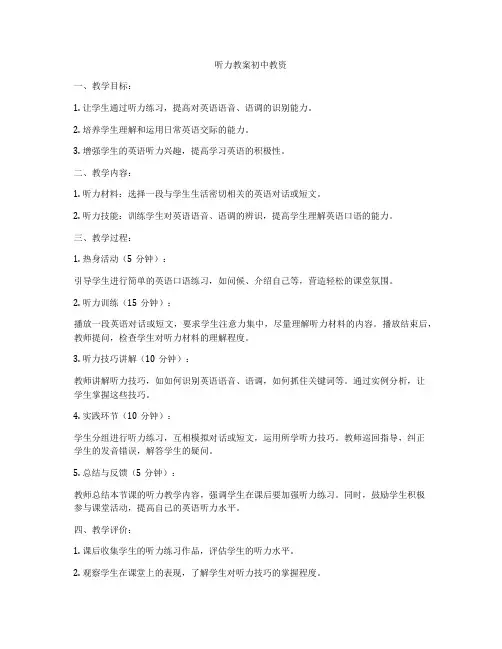
听力教案初中教资一、教学目标:1. 让学生通过听力练习,提高对英语语音、语调的识别能力。
2. 培养学生理解和运用日常英语交际的能力。
3. 增强学生的英语听力兴趣,提高学习英语的积极性。
二、教学内容:1. 听力材料:选择一段与学生生活密切相关的英语对话或短文。
2. 听力技能:训练学生对英语语音、语调的辨识,提高学生理解英语口语的能力。
三、教学过程:1. 热身活动(5分钟):引导学生进行简单的英语口语练习,如问候、介绍自己等,营造轻松的课堂氛围。
2. 听力训练(15分钟):播放一段英语对话或短文,要求学生注意力集中,尽量理解听力材料的内容。
播放结束后,教师提问,检查学生对听力材料的理解程度。
3. 听力技巧讲解(10分钟):教师讲解听力技巧,如如何识别英语语音、语调,如何抓住关键词等。
通过实例分析,让学生掌握这些技巧。
4. 实践环节(10分钟):学生分组进行听力练习,互相模拟对话或短文,运用所学听力技巧。
教师巡回指导,纠正学生的发音错误,解答学生的疑问。
5. 总结与反馈(5分钟):教师总结本节课的听力教学内容,强调学生在课后要加强听力练习。
同时,鼓励学生积极参与课堂活动,提高自己的英语听力水平。
四、教学评价:1. 课后收集学生的听力练习作品,评估学生的听力水平。
2. 观察学生在课堂上的表现,了解学生对听力技巧的掌握程度。
3. 定期进行英语听力测试,检验学生的听力进步情况。
五、教学资源:1. 英语听力材料:选择适合初中生水平的英语对话或短文。
2. 教学设备:录音机、多媒体课件等。
3. 学习用品:笔记本、耳机等。
六、教学建议:1. 注重培养学生的听力习惯,每天安排一定时间的听力练习。
2. 鼓励学生多听英语广播、观看英语电影,提高英语听力水平。
3. 教师要关注学生的个体差异,因材施教,使每个学生都能在听力教学中取得进步。
4. 定期进行听力测试,了解学生的听力水平,为教学提供有力依据。
通过以上教学设计,希望能够提高初中学生的英语听力能力,激发他们学习英语的兴趣,为今后的英语学习打下坚实基础。

英语听力训练教学教案教学目标:1. 提高学生的英语听力技能,培养学生听懂并理解英语口语的能力。
2. 培养学生对英语语音、语调、语速的敏感性,提高他们的听辨能力。
3. 培养学生的口语表达和听力反应的能力,增强他们的语言交际能力。
教学步骤:Step 1: 导入教师可以通过播放一段简单的英语对话或歌曲来引起学生的兴趣,并激发他们对英语听力训练的兴趣。
Step 2: 听力练习1. 给学生准备一些相关主题的听力材料,例如英语对话、新闻报道、广播节目等,根据学生的英语水平选择合适的难度。
2. 在播放前,教师可以先简要介绍一下材料的背景信息,让学生对内容有一定的预期。
3. 播放材料时,可以先全文播放一遍,让学生整体了解内容;然后进行逐句或逐段播放,让学生听写或理解其中的重点信息。
4. 播放完毕后,教师可以进行一些简单的提问,检查学生的听力理解情况。
也可以给学生分发相关问题的听力练习题,并让他们在规定的时间内完成。
Step 3: 听力策略教学1. 向学生介绍一些常用的听力策略,例如留意关键词、理解上下文、判断说话人的意图等。
2. 指导学生如何运用这些策略来进行听力理解。
3. 为了帮助学生掌握这些策略,教师可以选择一些相关的听力练习题,并与学生一起分析、讨论和解答。
Step 4: 反馈和评价1. 教师可以提供一些听力练习的参考答案,引导学生进行自我评价。
2. 教师也可以与学生进行小组或个别交流,了解他们在听力训练中的困难和收获,并给予相应的反馈和建议。
3. 鼓励学生在课后继续进行听力练习,培养自主学习的能力。
教学资源:1. 预先准备好的英语听力材料,可以是对话、新闻报道、访谈等,难度和内容根据学生的英语水平进行选择。
2. 听力练习题及答案。
3. 录音设备或电脑、投影仪等教学设备。
教学评价:通过教师的观察和学生的听力练习表现来进行评价。
可以评价学生的听力水平、听力策略的运用情况、对材料内容的理解等。
教学反思:1. 注意选择合适的听力材料,确保难度适中,能够让学生有所挑战但不至于过于困难。

英语听力课教案英语听力课教案一、教学内容本节课的内容是关于英语听力的基本技巧和方法。
二、教学目标1.了解英语听力的重要性并培养学生对英语听力的兴趣。
2.掌握一些有效的英语听力技巧和方法。
3.培养学生的听力能力,提高他们的听力水平。
三、教学步骤1.导入(5分钟)教师先向学生介绍本节课的内容,告诉他们听力在英语学习中的重要性,并鼓励他们积极参与听力练习。
2.技巧与方法(10分钟)教师向学生介绍一些提高英语听力的基本技巧和方法,如:带字幕听力训练、多听多模仿、边听边记笔记等。
同时,教师还可以向学生展示一些听力训练的网站和软件。
3.听力练习(25分钟)教师给学生播放一段英语对话或短文,并让学生进行听力练习。
学生可以选择边听边记笔记,或者边听边尝试听懂其中的一些关键词语。
之后,教师可以进行听力训练的评估,如:让学生回答一些与听力内容相关的问题,或者进行一些听力理解的小测验。
4.总结(5分钟)教师与学生一起回顾本节课的内容,总结学到的英语听力技巧和方法,并鼓励学生在日常学习中多多进行听力训练。
四、教学资源1.英语听力材料:一段对话或短文,可准备多个听力材料供学生练习。
2.电脑、投影仪等音频设备:用于播放听力材料。
3.笔记本和笔:供学生进行听力训练时记笔记使用。
4.网络资源:如听力训练网站、软件等。
五、教学反思本节课的教学内容较为简单,主要着重于介绍英语听力的基本技巧和方法,并让学生进行听力练习。
教师在课堂上起到引导和辅导作用,激发学生对英语听力的兴趣,培养他们的听力能力。
在听力练习环节,教师需要根据学生的实际情况选择适当的听力材料和评估方式,确保听力训练效果。
教师还可以通过反馈和评价,帮助学生发现和改进自己的听力问题,并鼓励他们多进行听力训练,提高听力水平。
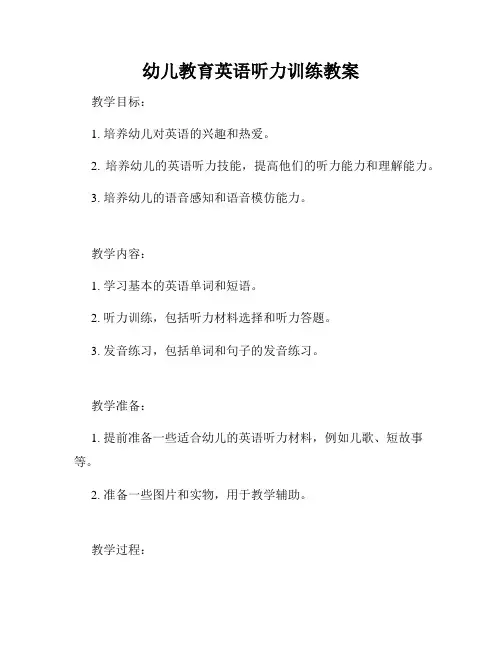
幼儿教育英语听力训练教案教学目标:1. 培养幼儿对英语的兴趣和热爱。
2. 培养幼儿的英语听力技能,提高他们的听力能力和理解能力。
3. 培养幼儿的语音感知和语音模仿能力。
教学内容:1. 学习基本的英语单词和短语。
2. 听力训练,包括听力材料选择和听力答题。
3. 发音练习,包括单词和句子的发音练习。
教学准备:1. 提前准备一些适合幼儿的英语听力材料,例如儿歌、短故事等。
2. 准备一些图片和实物,用于教学辅助。
教学过程:一、导入(5分钟)1. 老师向幼儿介绍今天的学习内容和目标,激发他们的学习兴趣。
2. 老师播放一段简单的英语儿歌,引导幼儿一起跟着唱。
二、听力训练(15分钟)1. 老师播放一段简短的对话或短故事,让幼儿仔细地听。
2. 老师提问关于听到的内容,例如 "What did you hear?" 或者"Who said..."。
3. 鼓励幼儿积极参与回答问题,纠正他们的发音错误,并给予肯定和鼓励。
三、词汇学习(15分钟)1. 老师用图片或实物展示一些英语单词,例如"apple"、"cat"等。
2. 老师发音清晰地读出单词,然后让幼儿跟读。
3. 老师提问关于单词的问题,例如 "What is this?" 或者 "What color is it?"。
4. 鼓励幼儿积极回答问题,并进行适当的奖励和鼓励。
四、听力答题游戏(20分钟)1. 老师准备一些听力题目,例如找出听到的单词、回答简单的问题等。
2. 老师播放听力材料,让幼儿听并回答问题。
3. 鼓励幼儿积极参与回答问题,并根据回答情况给予肯定和鼓励。
五、发音练习(15分钟)1. 老师选择一些常见的单词和短语,例如 "Hello"、"Thank you"等。
2. 老师发音清晰地读出单词和短语,并让幼儿跟读。
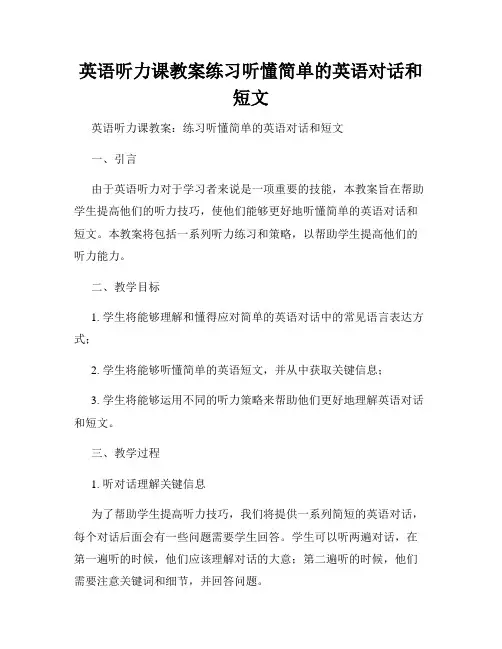
英语听力课教案练习听懂简单的英语对话和短文英语听力课教案:练习听懂简单的英语对话和短文一、引言由于英语听力对于学习者来说是一项重要的技能,本教案旨在帮助学生提高他们的听力技巧,使他们能够更好地听懂简单的英语对话和短文。
本教案将包括一系列听力练习和策略,以帮助学生提高他们的听力能力。
二、教学目标1. 学生将能够理解和懂得应对简单的英语对话中的常见语言表达方式;2. 学生将能够听懂简单的英语短文,并从中获取关键信息;3. 学生将能够运用不同的听力策略来帮助他们更好地理解英语对话和短文。
三、教学过程1. 听对话理解关键信息为了帮助学生提高听力技巧,我们将提供一系列简短的英语对话,每个对话后面会有一些问题需要学生回答。
学生可以听两遍对话,在第一遍听的时候,他们应该理解对话的大意;第二遍听的时候,他们需要注意关键词和细节,并回答问题。
2. 听短文获取关键信息在这个部分,我们将提供一些简短的英语短文,每篇短文后面也会有一些问题需要学生回答。
学生需要在听短文之前先看一下问题,这样能够帮助他们更清楚地知道自己需要注意哪些方面的信息。
同样地,学生可以听两遍短文,在第一遍听的时候他们应该理解短文的大意,在第二遍听的时候他们需要注意关键词和细节,以回答问题。
3. 听力策略的讲解和运用在这个部分,我们将向学生介绍一些常用的听力策略,这些策略可以帮助他们更好地理解英语对话和短文。
例如,学生可以通过预测猜测下一个可能的词或短语;他们可以注意说话者的语调和语气,以更好地理解其意思;他们还可以根据上下文和已知信息猜测生词的意思等等。
学生将有机会在实际听力练习中应用这些听力策略。
四、教学评估在教学的最后阶段,我们将给学生一些测试和练习,以评估他们对英语对话和短文的听力理解能力。
这些测试将模拟真实的听力考试情况,学生需要在规定的时间内听录音,并回答相关的问题。
五、课后作业为了巩固学生的听力技巧,我们将提供一些课后作业,例如请学生在家中多听一些英语对话或短文,并回答相关问题;学生还可以听一些英语录音材料,并进行笔记,总结出其中的关键信息等等。
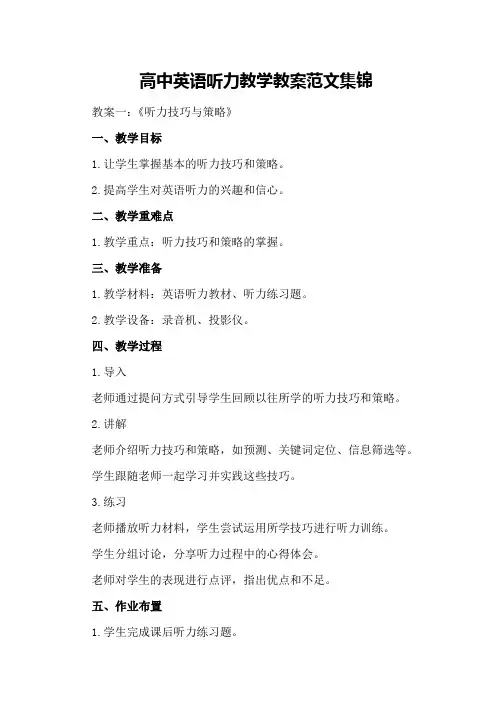
高中英语听力教学教案范文集锦教案一:《听力技巧与策略》一、教学目标1.让学生掌握基本的听力技巧和策略。
2.提高学生对英语听力的兴趣和信心。
二、教学重难点1.教学重点:听力技巧和策略的掌握。
三、教学准备1.教学材料:英语听力教材、听力练习题。
2.教学设备:录音机、投影仪。
四、教学过程1.导入老师通过提问方式引导学生回顾以往所学的听力技巧和策略。
2.讲解老师介绍听力技巧和策略,如预测、关键词定位、信息筛选等。
学生跟随老师一起学习并实践这些技巧。
3.练习老师播放听力材料,学生尝试运用所学技巧进行听力训练。
学生分组讨论,分享听力过程中的心得体会。
老师对学生的表现进行点评,指出优点和不足。
五、作业布置1.学生完成课后听力练习题。
教案二:《听力材料分析与解题技巧》一、教学目标1.让学生了解听力材料的特点和难点。
2.培养学生分析听力材料的能力。
3.提高学生解题技巧。
二、教学重难点1.教学重点:听力材料的特点和难点分析。
2.教学难点:解题技巧的培养。
三、教学准备1.教学材料:英语听力教材、听力练习题。
2.教学设备:录音机、投影仪。
四、教学过程1.导入老师通过提问方式引导学生回顾以往所学的听力材料特点。
2.讲解老师分析听力材料的特点和难点,如语速、语音、背景知识等。
学生跟随老师一起学习并实践分析听力材料的方法。
3.练习老师播放听力材料,学生尝试分析并解题。
学生分组讨论,分享解题过程中的心得体会。
老师对学生的表现进行点评,指出优点和不足。
五、作业布置1.学生完成课后听力练习题。
教案三:《听力实战演练》一、教学目标1.让学生将所学听力技巧和策略应用于实际听力训练中。
2.提高学生的听力水平。
二、教学重难点1.教学重点:听力实战演练。
2.教学难点:学生在实际听力过程中的问题解决。
三、教学准备1.教学材料:英语听力教材、听力练习题。
2.教学设备:录音机、投影仪。
四、教学过程1.导入老师通过提问方式引导学生回顾以往所学的听力技巧和策略。
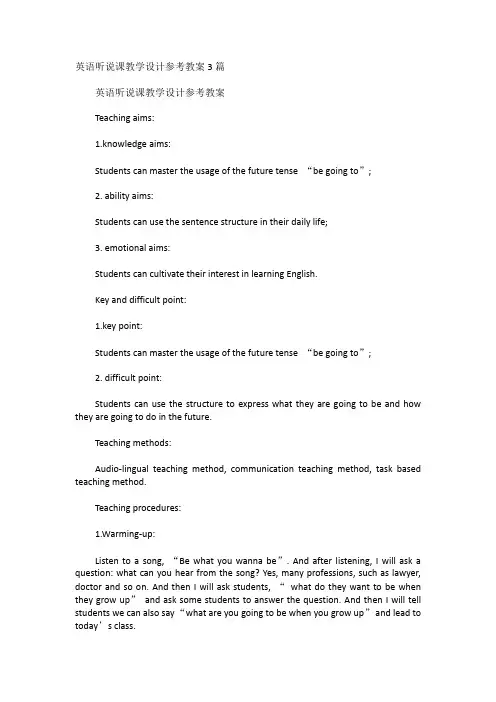
英语听说课教学设计参考教案3篇英语听说课教学设计参考教案Teaching aims:1.knowledge aims:Students can master the usage of the future tense “be going to”;2. ability aims:Students can use the sentence structure in their daily life;3. emotional aims:Students can cultivate their interest in learning English.Key and difficult point:1.key point:Students can master the usage of the future tense “be going to”;2. difficult point:Students can use the structure to express what they are going to be and how they are going to do in the future.Teaching methods:Audio-lingual teaching method, communication teaching method, task based teaching method.Teaching procedures:1.Warming-up:Listen to a song, “Be what you wanna be”. And after listening, I will ask a question: what can you hear from the song? Yes, many professions, such as lawyer, doctor and so on. And then I will ask students, “what do they want to be when they grow up”and ask some students to answer the question. And then I will tell students we can also say “what are you going to be when you grow up”and lead to today’s class.2. Pre-listening:I will show some pictures on the PPT, the first picture is about reporter and the second picture is about the article. I will write down the two words on the blackboard and then I will ask the students to read after me.3. While-listening:I will ask students to listen to the radio for the first time and then match the sentence with the picture on the ppt. The first picture is about the reporter, thee second picture is about writing magazines and the third picture is about Shanghai.Then I will ask students to listen to the radio for the second time and after listening, I will ask them to answer three questions on the blackboard, the first one is “What is he going to do when he grows up”, the second one is “how is he going to do for that”and the third one is “where is he going to work”.Lastly, I will ask students to listen to the radio for the third time and they need to read after the radio. And then I will divide the students into two groups, group A acts as A, and group B acts as B, and read the passage.4. Post-listeningWe will play a game called “hot potato”. When the music begins to play, students need to pass the flower. And when the music stops, the students who is holding the flower need to answer the question about “what is he going to do when he grows up, how is he going to do for that or where is he going to work”.And then we will have a group work, four students as a group and students need to make a survey about what is their group members going to be, how is he or she going to do for that and where is he going to work. Five minutes later, I will ask some groups to show their report.5. Summary and homeworkI will ask students to read the passage to summarize what we have learned today. After class, they need to search more information about the job they want to do.Blackboard designWhat are you going to be when you grow up?How are you going to do for that?Where are you going to work?英语听说课教学设计参考教案一、《英语课程标准》对初中阶段听、说的技能要求准确定位教学目标和宏观把握教学设计的依据是《课标》中规定的各级目标,教师要全面了解各学段的目标,以使自己在教学设计中能更好、更准确地把握。
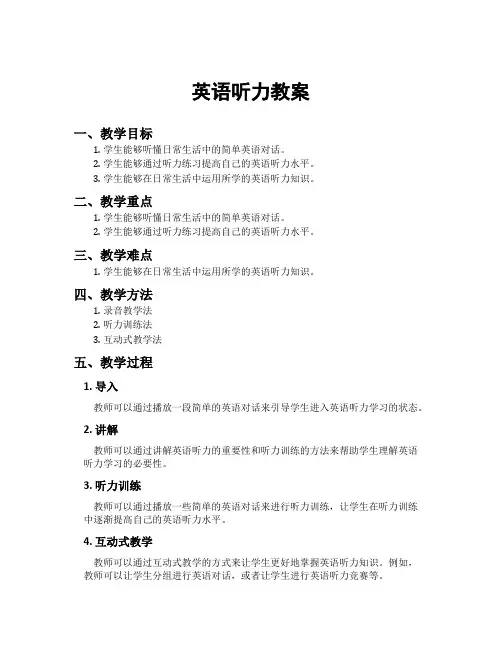
英语听力教案
一、教学目标
1.学生能够听懂日常生活中的简单英语对话。
2.学生能够通过听力练习提高自己的英语听力水平。
3.学生能够在日常生活中运用所学的英语听力知识。
二、教学重点
1.学生能够听懂日常生活中的简单英语对话。
2.学生能够通过听力练习提高自己的英语听力水平。
三、教学难点
1.学生能够在日常生活中运用所学的英语听力知识。
四、教学方法
1.录音教学法
2.听力训练法
3.互动式教学法
五、教学过程
1. 导入
教师可以通过播放一段简单的英语对话来引导学生进入英语听力学习的状态。
2. 讲解
教师可以通过讲解英语听力的重要性和听力训练的方法来帮助学生理解英语听力学习的必要性。
3. 听力训练
教师可以通过播放一些简单的英语对话来进行听力训练,让学生在听力训练中逐渐提高自己的英语听力水平。
4. 互动式教学
教师可以通过互动式教学的方式来让学生更好地掌握英语听力知识。
例如,教师可以让学生分组进行英语对话,或者让学生进行英语听力竞赛等。
5. 总结
教师可以通过总结本节课的内容来帮助学生更好地掌握英语听力知识,并鼓励学生在日常生活中运用所学的英语听力知识。
六、教学评价
教师可以通过听力测试、听力竞赛等方式来对学生进行英语听力水平的评价,以便更好地了解学生的英语听力水平,并针对性地进行教学。
七、教学反思
教师可以通过反思本节课的教学过程和效果来不断改进自己的教学方法,以便更好地帮助学生提高英语听力水平。
同时,教师也可以通过学生的反馈来了解学生的学习情况,以便更好地进行教学。

七年级英语听力教案英文版5篇七年级英语听力教案英文版5篇教师要在自己钻研教材的基础上,广泛地涉猎多种教学参考资料,向有经验的老师请教,而不要照搬照抄,要汲取精华,去其糟粕,对别人的经验要经过一番思考、消化、吸收,独立思考,然后结合个人的教学体会,巧妙构思,精心安排,从而写出自己的教案。
以下是带来的七年级英语听力教案英文版内容,感谢您的阅读,希望能帮助到您!七年级英语听力教案英文版1unit 5 text awhat are friends for? teaching objectives:by the end of the unit, students will be better able to1.understand the varied parts friendship plays in ones life and be betterfriends themselves;e about 30 new words and 10 new phrases and expreions in briefconversations, translation and preliminary writing tasks;e the subjunctive mood with implied condition in real lifecommunication;4.read material of a similar topic and degree of difficulty;5.know how towrite concisely by avoidingoverstated, pompous words and redundant phrases.teaching methods:audio lingual method; presentation; discuion; question-answer.important/difficult points:new words and expreions: chat, turtle, modelpick up, happen to, cd player, out of touch, put in perspective, betrayedconfidence on the planet, get rid of, in good/bad shapesome sentences in the text are difficult to understand, such as i wasthinking about how everybody can’t be every thing to each other, but some peoplecan be something to each other, but some people can be something to each other;wherever, whenever, there’s that spark of recognition; they have beautiful homesfilled with special handmade things presented to them by villagers in the remoteareas they have visited in their extensive travels. teaching procedure:step 1.warming up (30 mints)1) work in pairs or groups, and discu the following questions.? 1.do you have different kinds of friends? how do youclaify them?? 2.what is so great about friends?? 3.under what circumstances can one lose a friend?? 4.is it poible to love and hate a friend at the same time? giveexamples.2) ask students to skim the text for the 8 kinds of friends mentioned inthe text.buddies/ relative friends/ work friends/ former friends/ friends you loveto hate/ hero friends/ new friends 3) introducing the main idea of thearticleit is said that friends are the best gift god has given us.now that we haveeight kinds of friends from the text, what kind of happine or benefit can eachof them bring us? that’s exactly what the text is about.step 2.new words and the notes (20 mints) learn new words and expreions oftext aexplain some important and difficult words and expreions. cement n.水泥,粘合剂v巩固,粘牢nostalgic a.—nostalgia n.—nostalgically ad. subdivision n.—subdividev.—divide v. inopportune a.—(opposite) opportune a. invisible a.—(opposite)visible a. look at the notes on page 1161.marion wink: poet, eayist, and regular commentator on national publicradio’s.the author made up the capitalized expreions in th e text such as“faraway friend,” “relative friend,” which would make no sense at all out ofcontext, with the latter in particular.2.you quit doing drugs, you’re not such good friends with your dealeranymore: this is not meant to be taken seriously.poeion or sale of illegal drugscan result in long prison terms.step 3.key points (60 minutes)? 1.cry on sb.’s shoulder: get sympathy from someone when you tell themyour problems 向某人诉苦以寻求安慰(或同情)e.g.at least she hadn’t cried on his shoulder again.if you ever need ashoulder to cry on, just call me.? 2.in return (for sth.): as payment or reward for something作为报答或回报e.g.he is always helping people without expecting anything in return.we offer an excellent all-round(全面的,多方面的) education to our students.inreturn, we expect students to work hard. ? 3.they hold out through innumerablecrisesbefore...: they are alwaysreliable(可靠的,可信信赖的) and nice when you are in difficult times even thoughthey don’t like what you are doing... ? 4.while so many family relationships aretinged with guilt andobligation:while so many people may feel something of a sense of guilt orresponsibility in dealing with family relationships...? pany goip, once an infallible(绝对可靠的) source ofentertainment, soon awkwardly accentuates the distance between you: officechat used to be an effective way of amusement for you; however, it makes youfeel uneasy since you do not work together anymore and therefore increases thefeeling of distance between you.? 6.work friends share certain memories which acquire a nostalgic glowafter about a decade:memories of your work friends makes you happy after ten years, so yousomehow wish that you could return to those days.? 7.dead end: a street with no way out at one end or a situation from whichnomore progre in poiblee.g.he realized that the job at which he had been aiming all theseyearsseemed to him to be a dead end. he thinks they have reached anevolutionary(逐渐发展的,演变的) dead end.? 8.when you feel you’ve hit a dead end, come to a confusing fork intheroad, or gotten lost in some cracker-box subdivision of your life:whenever you feel helple, confused or at a lo(困惑的,不知所措的) in the complicatedjourney of your life...notice that “cracker-box division” is not a general expreion, but is rathermade up by the author.cracker: 薄脆饼干;咸饼干sth.: formal owning or having obtainedsomething from somewhere 占有(或拥有)某物e.g.she was found in poeion of stolen goods.how did the painting come into your poeion (=how did you get it) ? ? 10.todeath: informal used to emphasize that a feeling or emotion is very strong? be bored / scared / frightened etc.to deathshe was scared to death of what might happen next.i’m absolutely sick to death of it (=very angry, bored, or unhappy aboutsomething) .? bore / scare / love etc.somebody to deathhe drove at a speed which frightened leonora to death.she used to worry meto death.? 11.make me/you sick: spoken a) make you feel very angrye.g.people like you make me sick!b) indicate a feeling of jealousy — used humorouslye.g.you make me sick with your “expenses paid” holidays!? 12.wherever, whenever, there’s that spark of recognition(认识):when you me et a “new friend” for the first time you instantly feel aconnection with each other. step 4.aignment (5 minutes)1.read the article repeatedly and try to remember the new words andexpreions in text a2.finish the study and practice on page 118-130.the teaching plan of unit 5 what are friends for?(college english 2)english department sun xiaofang【篇3:全英文英语阅读课教案模板】阅读课教案school__ number3 middle school____junior or senior section _junior__ cla____3____ grade _1_______size ______45__ time_40_______date __2009-12-28____ materials __go forit______type of leon _reading ____ contents: 1.vocabulary: some nouns aboutfurniture and some daily use things: table, bed, dreer, bookcase, sofa, chair,backpack, books, keys, baseball, drawer, plant. some prepositions of place: on,in, under2.structure: where is (where’s)…?it is (it’s) in/on/under…where are…?they are (they’re) in/on/under… where’s/where’re…?i don’t know.is it /are they on/in/under… ?no, it isn’t./they aren’t./ yes, it is./they are.3.1) dialogue: where’s thebag?i don’t know.is it on the dreer?no, it isn’t.where are my books?i don’t know.are they on the bed?no, they’re not.2)writing: ask, gue and write objectives:1.instructional objectives (language knowledge and language skills)1) to promote students’vocabulary development (table, bed, dreer,bookcase, sofa, chair, backpack, books, keys, baseball, drawer,plant.…)2) to promote students’reading skills a) prediction b) skimming3) to promote students’oral english4) to develop students’writing skill cational objectives (affect,learning strategy and cultural awarene)1) to develop students’ability to communicate with others to getinformation2) to build students’confidence3) to make students learn to cooperate with others 3.personalobjectives:1) to develop teacher’s ability of claroom management focal points: a: thenouns. b: prepositions of place c: where- question andd: answers to “is the… in/on/under the …?”;difficult points: a: use the prepositions to describe position ofthingsb: use the where-question and is it-/are they -question to ask things’positionaids: ppt, blackboard, chalk … procedures and time allotment1.getting students ready for learning( mins) 1) greetings: good morningeveryone! 2) routine task: duty report2.revision: use some pictures to review the vocabulary ( table, bed, dreer,bookcase, sofa, chair, backpack, books, keys, baseball, drawer, plant, on, in,under) and sentence structure:where is (where’s)…?it is (it’s) in/on/underwhere are…?they are (they’re) in/on/under… 3.pre-reading :step1: vocabulary and some phrases learningtask: look at the conversation between them and gue the meaning of thesentences in red.( using the conversation between liu qian and a xin to showthose phrases to the students in order to learn them by the context; becausethesentence structure in the conversation is those they have learnt)(… mins)此步骤包括词汇、语法教学等 4.while-reading 5.post-reading(… mins)1) oral work 2) written work 6.aigning homework1) conclusion: a: vocabularyb: sentence patterns: where is (where’s)…?it is (it’s) in/on/under…wher e are…?they are (they’re) in/on/under…where’s/where’re…?i don’t know.is it /are they on/in/under… ?no, it isn’t./they aren’t./ yes, it is./they are. 2) homework: ask, gue andwritelet your partner to ask as well as gue where your things are in yourroom.write down your conversation by using the following sentence patterns:a: where’s/where’re your…? b: you can gue.a: i don’t know.is it /are they on/in/under… ?b: no, it isn’t./they aren’t.yes, it is./they are.…self-evaluation七年级英语听力教案英文版2Unit 16 Leon 63Hello, everyone.Today I’m very pleased to have an opportunity to talk aboutsome of my teaching ideas.My topic is life in the oceans taken from Leon 63 ofUnit 16 in SEFC(2).It is made up of four parts.Part 1 My understanding of this leonThe analysis of the teaching material:This leon is a reading paage.It plays a very important part in the Englishteaching of this unit.Leon 62 and Leon 63 are a whole unit.By studying Leon 63,Ss can improve their reading ability, learn more about the sea and the life inthe oceans.At the same time, we should get the students to understand somedifficult sentences to comprehend the paage better.The Ss should do somelistening, speaking and writing, too.Of course, the Ss should receive some moraleducation.Let the Ss understand the sea better, love the sea and save the seaand the life of the sea.Teaching aims:1.Knowledge aim:Understand the main idea of the text.2.Ability aim:Retell the text in their own words.3.Emotional aim:Make the Ss love the life of the sea and do something tostop it being polluted.Key points / Teaching important points:How to understand the text better.Teaching difficult points:e your own words to retell the text.2.Discu the pollution of the sea and how to save the sea.Something about the Ss:1.The Ss have known something about the sea and sea life through theInternet and other ways.2.They are lack of vocabulary.3.They don’t often use English to expre themselves and communicate withothers.4.Some Ss are not active in the cla because they are afraid of makingmistakes.Part 2 My teaching theories, methods and aidsBefore dealing with this leon, I’ll do my best to carry out the followingtheories:Make the Ss the real masters incla while the teacher himself acts asdirector; Combine the language structures with the language functions; Let thestudents receive some moral education while they are learning the Englishlanguage.Teaching method:Double activities teaching methodQuestion-and-answer activity teaching methodWatch-and-listen activityFree discuion methodPair work or individual work methodTeaching aids:1.a projector2.a tape recorder3.multimedia4.the blackboardPart 3.Teaching steps / proceduresI have designed the following steps to train their ability of listening,speaking, reading and writing, especially reading ability.The entire steps are:Greetings, Revision, Lead-in and preparation for reading, Fastreading(scanning), Listening, Intensive reading,Preparation for details of thetext, Consolidation, Discuion, HomeworkStep 1 GreetingsGreet the whole cla as usual.Step 2.Revision1.Ask students some questions to revise the last leon(show them on thescreen).a.How much salt do the oceans contain per thousand parts of water?(35 partsof salt.3.5% by weight)b.What is coral? Why are corals not found in deep water?c.Why is the Dead Sea called the Dead Sea?2.Check the homework(made a survey about the sea or sea life by surfing theInternet or asking for help from other people).Through this part we canconsolidate what they studied yesterday, communicate with others about theirsurvery results and prepare for the new leon.Step 3.Lead-in and preparation for readingShow them some pictures and let them talk each other, and then use thepictures about sea and life in the oceans to learn new words, for example,Antarctica, huge whale, sperm whale, squid and so on.Purpose:Arouse the students’interest of study.Bring in new subject:Life in the oceans.Step 4.Fast readingRead the paage as quickly as they can.I show the questions on the screenand let them get the main idea of each paragraph:1.Why can living things live in such oceans around the Antarctica?2.What does the whale feed on?3.What is the difference between the sperm whale and other whales?Method:Read the text individually, use question—and—answer activity.Purpose:Improve the students’reading ability.Understand the general idea of each paragraph.Step 5.Listening(book closed)1.Listen to the tape then do an exercise(wb page 90, part 1)2.True or false exercise.(on the screen)Train the Ss’listening ability and prepare for later exercises.Step 6.Intensive readingRead the paage carefully again and answer some detailed questions on thescreen.1.How much does a whale eat at a time?2.Do all the whales feed on small fish?3.How deep can a sperm whale dive?It is also called depth reading or study reading.It means reading fordetailed information.Purpose:Further understand the text (Train further reading ability) tofind out some different sentences and details of the text.Step 7.Preparation for details of the text on the screen1....its heart slows to half its normal speed.slow-v.to become / make slower.ing sound wavePresent participle used as adverbial.3.provide sth.for sb.provide sb.with sth.4.at a time:each time5.grow to a length of...Purpose:Train the Ss’ability of understanding and using laguage.Step 8.Consolidation1.Find out the topic sentences.2.Retell the paage according to the topic sentences.Purpose:I want to know if my students understand the whole text really andif they master what I mean to tell them in this cla.What’s more, I want to letthem have the ability of introducing and analyzing expreion.At the same time, Iwill write down the topic sentences on the blackboard according to what thestudents find, so they can retell it easily.Step 9.DiscuionShow them some pictures about the polluted sea and many living things whichare in danger and ask them:What are their opinions about it? In order to letthem have free choice, I give them another topic:The sea is being polluted.Whatshould they do?Purpose:I mean to give them emotional education.I give them multi-mediapictures to arouse their interest of study and their love for life.I mean tomake them realize:The sea is in danger!I teach them to do their best to help it and do something from nowon.Everyone should do something to love and protect our home.Step 10.HomeworkWrite an article Saving the sea.I want to improve the ability of theirwriting.At the same time, train the ability of do-it-yourself and looking up theinformation by themseleves.Part 4.Blackboard designUnit 16 Leon 63Topic Sentences:1.Some living things can live in Antarctica.(what)2.The whale feeds on small fish.(what)3.The sperm whale feeds on squid.(difference)Discuion:1.The whales are in danger.What’s your opinion about it?2.The sea is being polluted.What should we do?In my opinion, the blackboard design can reflect the teacher’s ability ofmastering the text and leading the students to master the text easily.In this text, the design is not easy to write.I write the topic sentenceson the blackboard in order to tell the students that this is of the importancein this cla.The discuion is of the difficulty.I want to make the design inductive, instructive and artistic.七年级英语听力教案英文版3一、导入Presentation: 听一听:找出下列单词的发音A:cat bag rat sad apple B: set bed get wet red C: sit bigpig zip his 让学生找出每组单词中的相同发音,并将音标写在白板上进行一对一教学/æ/ /e/ /i/ Groupwork:让学生分组进行填空比赛cat /k___t/ bag /b___g/ map /m___p/ jam/dʒ___m/ fat /f___t/ yes/j___s/ red /r___d/ wet /w___t/ jet /dʒ___t/ pen /p___n/ sit /s___t/ big /b___g/zip /z___p/ fit /f___t/ him /h___m/二、交际用语/ 常用对话——问候、告别Lead in 老师设置场景进行场景交际用语的教授A: Hi!/ Hello!A: Good morning / afternoon / evening /night.A: How are you? / How are youdoing?A: Good-bye / Bye / Bye-bye.A: See you later / tomorrow / soon… A: Nice /Glad to meet you.A: Are you OK / all right? A: How is everything with you?How is it going?Group work: role-play三练习Practice 1.音标辨音B: Hi!/ Hello!B: Good morning / afternoon / evening /night.B: I’m fine / OK.Fine / Very well, thank you.Just so so.Not very good./ …B: Good-bye / Bye / Bye-bye.B: See you.B: Nice / Glad to meet you, too.B: Yes, I’m OK./ All right.B: Just soso.Very good./ Everything is going well.Listen to the teacher ,listen to thewords in the sentences and tell the teacher the sound of the word.e.g.”yesterday I was very sad” “it is a big dog” “I like color red”2.根据对话选出正确的答案:Set 1 () 1. Who is that girl? A.Lily B.Jeica C.Kate () 2. Where are they now? A.At home.B.In a shop.C.At school.() 3. Is the boy, Michael, a new student? A.Yes, he is.B.No, he isn’t.C.Heis a new student, too.Look at the questions and gue what is the dialogue about?And then listen to thetape and do the exercises.四、随堂检测Production 音标辨音选出正确的音标:() 1.A./æ/ () 2.A./е/ () 3.A./i/ () 4.A./æ/ () 5.A./æ/ () 6.A./е/ () 7.A./i/ () 8.A./æ/ () 9.A./i/ () 10.A./æ/听句选答根据录音选出正确的应答:() 1. A.I’m fine, thanks.() () () () () () () () () 2. A.Hi, every one.3. A.See you.4. A. Glad to meet you, too.5.A.Good-bye! 6. A.I’m fine, thanks.7. A.Please don’t go.8. A.Yes, I do.9. A.Verywell, thanks.10. A.It’s a dream.B.B.B.B.B.B.B.B.B.B./е/ /æ/ /æ/ /i/ /е/ /æ/ /æ/ /i/ /æ/ /i/C.C.C.C.C.C.C.C.C.C./i/ /i/ /е/ /е/ /i/ /i/ /е/ /е/ /е/ /е/B.How do you do? B. Good morning, teacher.B.Meet at 7:00 p.m.B. Nice tomeet you.B.Hi, Mary.B.How do you do?B.Good-bye! B.That’s all right.B.How do youdo? B.Good night.C.I’m seven years old.C. Nice to meet you! C.I’m fine.C. Hello, Sam.C.Howare you? C.I’m seven years old.C. See you at your home.C.I’m OK now.C.I’mfive.C.Good evening! Set 2 () 4.Who is Mr.Smith’s new friend? A.Lily B.Li Hua () 5. When is it now?C.Lin Lin A.In the afternoon.B.In the morning.() 6. How is Li Hua today? A.She’s fine.B.Not very good.Set 3 () 7. Is Tom in the dancing group? A.Yes, he is.B.No, he isn’t.() 8. What are Mary and Amy going to do? A.Play table tennis.B.Playsoccer.() 9. Does Tom go with them together? A.Yes, he does.B.He is not sosure.C.In the evening.C.Just so so.C.Mary is in the group.C.Play tennis.C.No, he doesn’t.七年级英语听力教案英文版4内容:Unit 1 《The new term》目的:听大意复述所听内容T: Now cla, we are going to listen to a dialogue you need to listencarefully ,because I need you to repeat the content you listen and tell me themain ideal at the first time.Understand? Ss:Yes ,We understand! T: Ok.Let’sstart.(Plays the tape once)Well ,who can tell me the main ideal about the radio? Ss:It talk about thenew term.T:You are so clever! Now let us listen again !(Plays the tape again)T:Who can repeat ?Can you?(Ask a student) S:I’m sorry just a little.T:Ok, Thistime we listen sentence by sentence you can write down the sentence you arelistening.Ok? Ss:OK(play the tape the third time) T:Now who can repeat it?(asksome students to repeat) At last I will show you the content you can check youranswer!(listen the radio last time).七年级英语听力教案英文版51.unit 1 festivals around the world2.teaching aims of this unittalk about festivals and celebrationstalk about the ways to expre request and thanks learn to use modalverbswrite a similar story with a different ending 3.sentencepatterns:request:could/ would you please…?could i have…?could we look at…?i look forward to…may i see…? thanks:it?s very kind of you…thank you very much/ thanks a lot. i?d love to.it was a pleasure… don?t mention it.you are most welcome. 4.modal verbs:may might, can could will would must can the first period 1.teachingaims:could i have…?…?may i see…? we might take…teaching procedurest: everybody! welcome back to school! did you have a good time in yourwinter holidays? .yes.of course!t: when did you feel most happy and excited? : at the spring festival.t: who can tell us why? any volunteers?s1: because it is the most important festival in our country. s2: because igot a lot of lucky money from myparents. s3: because i needn?t study atfestivals and there was a lot of delicious food to eat. how great.s4: because i met my cousins and friends who i hadn?t seen for a longtime.t.very food! i am glad to hear that.today we will talk about festivals,which aremeant to celebrate important events.please think about some otherfestivals.can you name just a few?: new year, yuan xiao festival…:t: quite right.that?s called the lantern?s festival.how about some otherfestivals?: the army day, international labour?s day, national day, tomb sweepingfestival, dragon boat festival, mid-autumn day… t: you have done a goodjob, boys and girls! . s tep Ⅱwarming –up like best---the music, the things to see, the visits or the food? stepⅣaignment 1.consolidation2.listening to the material again after cla to be familiar with it.3.homework: collect as much information about festivals as poible.the second period reading teaching aims1.vocabulary: starve, starvation, plenty, satisfy ancestor lamps lead feastbone originin memory of dre up trick poet arrival national gain independencegather agricultural european custom awards watermelon handsomerooster admire look forward to religious as though have fun with daily2.to enable the students to know the earliest festivals with reasons forthem and four different kinds of festivals that occur in most parts of theworld3.to enable the students to master some english expreions and phrasesfestivals.4.teach the basic reading skills: skimming and scanning.5.try to compare and make conclusion s of different festivals. stepⅠrevision 1.greetings.2.review the new words of this part.3.check the students? homework---festivals step Ⅱreading 1.scanning( four minutes later, with the whole cla.show the suggested ( allow to readaloud and carefully this time to understand the main3.reading and discuiont: read the text a third time and then work impairs to do exercise 2 onpage 3.( let the students have enough time to read the paage carefully and discuthe chart with their partners.encourage them to expand their answers accordingto their own experiences.) 4.explanation(in this part try to help the students analyse the difficult, long andcomplex sentences and gue the meaning of the new words; ask them to deal withthe language points in the context.)t: now i will discu some important sentences and phrases in the paage.a.some festivals are held to honor the dead, or satisfy and please theancestors,who could return either to help or to do harm. b.in memory ofc.the leader who helped gain india?s independence from britain.d.a season of agricultural work is over.e.the end of winter and to the coming of spring.f.be covered with pinksnow. the suggested explanation: a.anattributive clause.dead or to make happy in case they might come back to do harm. b.(hoping) (defending)c.→energetic adj.( full of or done with energy) look forward to ( to is apreposition here.)devote to, be/get used to, get down to , stick to e.g.i?m looking forwardto hearing from you. step Ⅲ listening t: now i will play the tape for you.you can just listen with your booksclosed or look at your books or read in a low voice together with the tape.it?sup to you.after listening, please write down three things that most festivalsseem to have in common.( comprehending ex.3 on page 3). the third periodlearning about language teaching aims:1.let the students know the usage of modal verbs.2.enable the students torecognize the words and expreions in the reading paageaccording to what mean the same as them. step Ⅰ greeting and revision( ask some students to retell the text we learned .)stepⅡ.practicing the useful words and expreions t: as we know, there aretwo important kinds of and intransitiveverbs.but many intransitive verbsstructure on. the words given.s2: we are talking about verbs.s3: would you like to talk with me?step Ⅲ verbs form and try to explain their meanings.if you have anystepthe usage of modal verbs.i think it is not easy for you to master them,after cla you should review them. homework1.practice of wbp42ex.1,2,3.2.please find out10 sentences with modal verbs, and try to get theirmeanings.the fourth period listening。

英语听力教学教学教案英语听力教学教案教学目标:1. 帮助学生提高英语听力水平,能够听懂日常对话和简单的英语文章;2. 培养学生的听力注意力和听辨能力;3. 提升学生的听力自信心和积极性。
教学内容:1. 听力材料的选择与使用;2. 听力训练活动的设计;3. 听力评估方法。
教学步骤:一、导入新知(5分钟)通过简短的问题或图片引入本课听力内容,激发学生学习英语听力的兴趣。
二、听力材料选择与使用(15分钟)1. 根据学生的年龄、水平和兴趣选择适当难度的听力材料,如英语歌曲、对话、短文等;2. 在选择听力材料时,注意材料的质量、内容的连贯性和难度的适应性;3. 使用多种形式的听力材料,如录音、视频、在线资源等。
三、听力训练活动设计(35分钟)1. 预测性听力活动:- 利用图片、单词或简单问题让学生在听材料前猜测答案,激发学生的预测和猜测意识。
- 提示学生关注特定的信息,如时间、地点、人物等。
2. 聆听理解活动:- 给学生听一段对话或短文后,提问相关问题,检验学生听力理解的能力。
- 让学生根据听到的内容完成填空、排序、选择等练习,加强听力注意力的培养。
3. 对话模仿活动:- 播放一段对话或短文后,让学生模仿录音中的语音语调、语速等,提高语音语调的准确度。
4. 听力情景交际活动:- 设置真实的听力情景,如购物、问路、约会等,让学生通过听力练习提高应对不同情境的听力能力。
四、听力评估方法(10分钟)1. 老师通过观察学生的参与程度、回答问题的准确度以及对听力材料的理解程度来评估学生的听力能力;2. 可以采用问答、小组讨论或听力测试等形式进行听力评估;3. 鼓励学生互相评估,在小组活动中进行听力互动与评价。
五、复习与总结(5分钟)对本课的内容进行复习和总结,强调学生在听力训练中的进步和需要改进的地方。
教学注意事项:1. 在进行听力训练活动时,要根据学生的实际水平和需求进行调整,既要保证学生的听力挑战,又要避免过度困难;2. 引导学生学会运用不同的听力策略,如预测、猜测、推理等,提高听力理解能力;3. 让学生积极参与听力活动,鼓励他们表达自己的想法和理解。
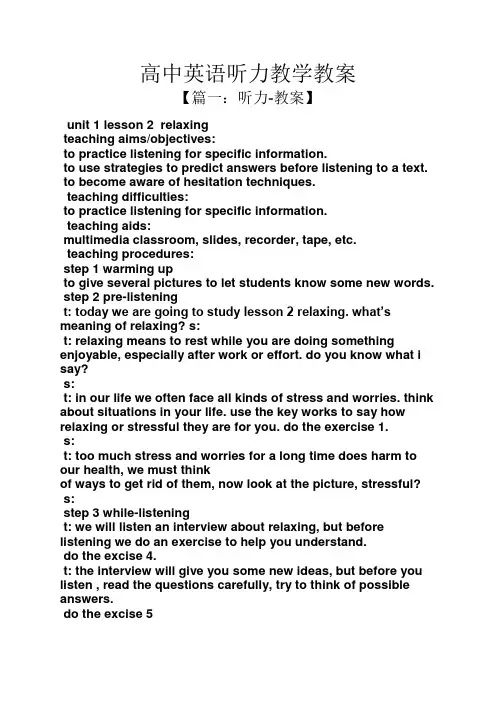
高中英语听力教学教案【篇一:听力-教案】unit 1 lesson 2 relaxingteaching aims/objectives:to practice listening for specific information.to use strategies to predict answers before listening to a text. to become aware of hesitation techniques.teaching difficulties:to practice listening for specific information.teaching aids:multimedia classroom, slides, recorder, tape, etc.teaching procedures:step 1 warming upto give several pictures to let students know some new words. step 2 pre-listeningt: today we are going to study lesson 2 relaxing. what’s meaning of relaxing? s:t: relaxing means to rest while you are doing something enjoyable, especially after work or effort. do you know what i say?s:t: in our life we often face all kinds of stress and worries. think about situations in your life. use the key works to say how relaxing or stressful they are for you. do the exercise 1.s:t: too much stress and worries for a long time does harm to our health, we must thinkof ways to get rid of them, now look at the picture, stressful?s:step 3 while-listeningt: we will listen an interview about relaxing, but before listening we do an exercise to help you understand.do the excise 4.t: the interview will give you some new ideas, but before you listen , read the questions carefully, try to think of possible answers.do the excise 5t: now let me test your remembering ability, you read through the questions, answer them if you can remember any of the answers.students listen to the cassette again and answer the questions. do the exercise 6.t: we will listen to mark’s dialogue about relaxing and stress. i guess maybe you will have the same feeling and experience. pay attention to his stressful actives and relaxing actives to fill the blank.when students have checked their answers, ask them “before exams and before going to parties what do you do to avoid much too stress?do the exercise 7students look at the function file activity and see if they can remember or can guess any of the missing verbs.students listen to the cassette again and complete the sentences in the function file. remind students of these words’ character: v + ing.do the exercise 9in our oral language we often pause. now listen to mark again. which words or sounds does he use to hesitate?students listen to the cassette. after each sentence, pause the tape so that students can repeat the hesitation device.step 4 post-listeningpair-workin pairs students act out a role play in which one person is not sure what to say and so uses a lot of hesitation words. for example, you borrow your friend’s favorite cd last week. now she ask you for it back you can’ t find it.step 5 homeworkdo exercise 2 in the text.design of the blackboard writingunit 1 lifestyleslesson 2 relaxingstress, stressful, pressurestudiodietreflectionsfrom this text, students learn not only the new vocabulary but learn more about the relaxing activities and stressful activities.whats more, learning to use the new knowledge is very important. practice makes perfect. so , much exercise is necessary. this text aims at developing students’ ability to find some specific information,giving homework can help them master the knowledge better.【篇二:高中英语听力说课稿】听力说课稿模板总结教材:本次说课的内容是单元听力部分。
小学英语听力训练教案一、教学目标1、提高学生对英语语音、语调的感知能力。
2、增强学生对简单英语对话和短文的理解能力。
3、培养学生从听力材料中获取关键信息的能力。
4、帮助学生建立英语听力的自信心和兴趣。
二、教学重难点1、重点(1)让学生熟悉常见的英语语音、语调模式。
(2)训练学生听懂日常生活中的简单英语对话,如问候、介绍、购物等。
2、难点(1)帮助学生克服听力过程中的紧张情绪和畏难心理。
(2)引导学生在听力材料中快速捕捉关键信息,如数字、时间、地点等。
三、教学方法1、情境教学法:通过创设生动的英语听力情境,让学生在实际情境中感受和理解英语听力。
2、任务驱动法:布置明确的听力任务,引导学生有目的地进行听力训练。
3、互动教学法:鼓励学生之间进行互动交流,分享听力技巧和心得。
四、教学准备1、相关的英语听力音频材料,包括对话、短文、歌曲等。
2、多媒体教学设备,如投影仪、音响等。
3、教学卡片、图片等辅助教具。
五、教学过程1、导入(5 分钟)通过播放一首简单的英语歌曲,如《Hello Song》,引导学生跟唱,营造轻松愉快的英语学习氛围。
然后提问学生歌曲中听到了哪些单词和句子,引出本节课的主题——英语听力训练。
2、听力技巧讲解(10 分钟)(1)介绍听力前的准备工作,如放松心情、集中注意力、快速浏览题目等。
(2)讲解如何根据题目中的关键词和选项预测听力内容。
(3)强调听力过程中要注意语音、语调、连读、弱读等现象。
3、基础听力训练(15 分钟)(1)播放一段简单的英语对话,内容涉及问候、自我介绍等。
播放第一遍时,让学生整体感受对话的内容;播放第二遍时,让学生根据听到的内容回答问题,如“Who are they?” “What do they say?”等。
(2)再次播放对话,让学生模仿对话中的语音、语调进行跟读,加深对听力内容的理解和记忆。
4、拓展听力训练(15 分钟)(1)播放一段稍长的短文,如介绍动物的生活习性。
哈尔滨学院英语听力教案一、教学目标1. 提高学生英语听力理解能力,使他们能够听懂日常生活中的英语对话和短文。
2. 培养学生对英语听力的兴趣,激发他们学习英语的积极性。
3. 帮助学生掌握一定的听力技巧,提高听力解题速度和准确率。
二、教学内容1. 日常英语对话:涉及问候、介绍、道别、询问等情境。
2. 短文理解:包括故事、人物介绍、地点描述、新闻报道等。
3. 听力技巧:如预测、关键词定位、信息筛选等。
三、教学方法1. 任务型教学法:通过完成各种听力任务,提高学生的实际应用能力。
2. 互动式教学法:鼓励学生积极参与课堂讨论,提高他们的口语表达能力。
3. 直观教学法:利用图片、视频等多媒体手段,帮助学生更好地理解听力材料。
四、教学评估1. 课堂参与度:观察学生在课堂上的发言和互动情况,评估他们的兴趣和积极性。
2. 听力练习成绩:定期进行听力测试,评估学生的听力水平和进步情况。
3. 个人成长记录:记录学生在听力方面的优点和不足,为学生提供个性化的指导和建议。
五、教学资源1. 听力教材:选用适合我国学生水平的英语听力教材,如《新概念英语》、《英语听力教程》等。
2. 多媒体设备:如投影仪、电脑、音响等,用于播放听力材料和辅助教学。
3. 网络资源:利用网络平台,为学生提供更多的听力素材和在线学习资源。
六、教学安排1. 第一阶段:日常英语对话训练(2周)目标:使学生能够熟练听懂并参与日常英语对话。
2. 第二阶段:短文理解训练(3周)目标:提高学生对短文的理解能力,能够抓住主要信息和细节。
3. 第三阶段:听力技巧训练(2周)目标:培养学生掌握听力技巧,提高听力解题速度和准确率。
4. 第四阶段:综合训练与测试(2周)目标:综合运用所学知识和技巧,提高学生的英语听力水平。
七、教学步骤1. 热身活动(5分钟)通过简单的听力练习或口语互动,调动学生的积极性,营造轻松的课堂氛围。
2. 听力训练(20分钟)根据当天的教学内容,播放相应的听力材料,要求学生认真听并回答问题。
5篇高中英语听力教案范文5篇高中英语听力教案范文教学计划是教学活动得以顺利进行的基本保证。
好的教学设计可以为教学活动提供科学的行动纲领,使教师在教学工作中事半功倍,取得良好的教学效果。
以下是带来的高中英语听力教案范文内容,感谢您的阅读,希望能帮助到您!高中英语听力教案范文1课型设计与课时分配1st period warming up(6.3-6.4)2nd period Reading (I)(6.5)3rd period Reading(II)(6.9)4th period Language Study(6.10-6.11)5th period Listening(6.12)6th period Writing(6.13)Ⅳ. 分课时教案The First Period warming upTeaching goals 教学目标1. Target Language目标语言a. 重点词汇和短语misunderstand, similar, facial, expression, agreement, yawn, chest,gesture, adult, punishb. 重点句型或交际用语Act out the following meanings, please.Please guess what I mean.Please show the actions, using body language.Now it is your turn to show the action / gesture.Please use either spoken words or body language to express your ideas.Please use both spoken words and body language to express your ideas.2. Ability goals能力目标a. Enable the students to understand what a certain gesture of the bodylanguage means in a given situation.b. Enable the students to act out some meanings, requirements, requests orsituations given in the target language.c. Enable the students to express with the target language the meaningsgiven in body language.3. Learning ability goals 学能目标a. Help the students learn how to express themselves in body language whenneeded.b. Help the students understand others when body language is beingused.Teaching important points教学重点a. Teach the students how to understand body language used in differentcountries or cultures as well as in different occasions.b. Teach the students how to use body language in the most appropriateoccasions.Teaching difficult points 教学难点a. Enable the students to realize the importance of body language incommunication so that little or no misunderstanding may occur.b. Let the students know that there is both positive body language andnegative body language.Teaching methods教学方法a. Individual work, pair work and group work.b. Acting out by imitation, mime or with gestures and body movement.Teaching aids教具准备A computer, a projector and some pictures.Teaching procedures ways教学过程与方式Step I Lead-inThe teacher shows some pictures on screen. These pictures are from theEvening Party Celebrating the comingLunar New Year of the Rooster of 2005.Ss: Yes, Thousands of Hands Kwan-yin.T: But do you know who she is? Yes, she was the leading dancer of theprogram. Her name is Tai Lihua(邰丽华). She is called a Fairy of Peachblossom(桃花仙子) by people. You know she is a deaf girl, but she is a wise,diligent, charming and energetic girl. She studied very hard and got two degreesof bachelors in university. She was famous as an artist for her wonderfulperformance. She is deaf and dumb. But how did she get that great achievementand became a successful person? She loves life very much. We should learn fromher spirit. Besides her hard working, body language plays a very important partin her life. We are all healthy people, sometimes we can use body language toexpress ourselves. So we should pay more attention to learning bodylanguages.Step II IntroductionT: Now let’s do some TPR (Total Physical Response) activities together, Ihope you will enjoy them and have fun as well.Touch your head / face / eyes / nose / mouth / ears / cheeks / forehead /shoulders / stomach / legs / feet / toes ...Shake your head / arm / hand ...Wave your arm / hand ...Open your eyes / arms /mouth ...Close your eyes / mouth ...Twist your wrist / waist.Cross your arms / fingers.Nod your head. Bow your head.Make a face to each other.Bend / cry / shout / scream / smile / laugh ...T: All right. Now let’s do them a little bit difficult. Let’s play a gametogether. Those who fail to follow the rule of the game will be dropped out. Thegame is: “Simon says”. For example, if I sa y “Simon says, touch your head”, thenyou touch your head. If not, you shouldn’t touch your head but remain still.Clear? Ready? Now let’s start.3 or 5 minutes for the game.T: Ok. It’s time to take up the lesson. Please look at the screen. Let’stake a look at the following gestures: Gesture Action MeaningA handshake You are welcome.A clap of hand Come on; be cheerful.A V-shape of the fore-finger and middle finger Mayyou succeed!Or congratulations on your success!A half-closed hand with thumb down I am not in favor of your idea or I’llhave to refuse you.A wrinkling of the brow in thought or displeasure or a scowl She isworried.Tears coming out of his eyes. He is very sad.All smiles on her face She is very happy.Waving their hands They are waving goodbye to people around.A hand stretched out forward with strength He is stopping a tank.People jump with their both hands stretched open in the air. They arecheering for the victory.T: What are the actions of the above gestures? What do they mean?S4: The first gesture is a handshake, which means “You’re welcome”.S5: The second is a handclap, which means “Come on” or “Be cheerful” orsomething like that.S6: The third one is a V-shaped posture of the first finger and the middlefinger, which suggests a wish for the。
初中英语听力教案(精选5篇)学校英语听力教案精选篇5Unit 1 How do you study for a test ?(Section A 1b,2a,2b)教学内容分析本单元学习一般现在时和现在完成时的用法,其话题是“谈论怎样学习”围绕同学自己的学习方法“I study by doing …”绽开,使同学通过听力训练,针对学习中的困难给别人提出建议,并对别人的学习方法做出评价,使同学在学习的过程中能够借鉴别人胜利的学习方法。
教学目标1、让同学通过听,学会用“by+doing”短语表达学习方法。
2、能听懂有关熟识话题的谈话,并能从中提取信息和观点。
3、能针对所听语段的内容记录简洁信息。
4、让同学通过听,了解英美国家同学学习英语的方法。
教学重难点重点:学会用“by+doing”短语表达学习方法。
难点:通过听,正确运用英语表达自己学习英语的学习方式及遇到的困难。
教学预备老师预备:多媒体课件、录音机。
同学预备:收集学英语的方法。
教学步骤Step 1: Lead inLet several students talk about their ways to study English one by one .A: I study by working with a group.B: I study by listening to tapes.C: I study by making flashcards.…Step 2: ListeningTask 1: Listening(1b)Before listening . Ask students to look at the pictures from a to c carefully and try to express how these students study for a test.Picture a: She studies by making flashcards. Picture b: He studies by listening to tapes. Picture c: He studies by asking the teacher for help.While listening . Students try to grasp the details and write letters from the pictures above. Then check the answers together.(It’s easy for students to find the right answers.)Answers:1、a2、c3、bAfter listening . Ask students to recite the target languages and then act them out .Model :S1: How does Mei study for a test ?S2: She studies by …Task 2: Listening (2a,2b)Before listening . Ask the students to look at the picture and answer the teacher’s question .T : What are doing ?Ss:…Ask students to read questions from 1 to 5 and answer from a to d and pay attention to the structures of the sentences .While listening . Ask the students to listen twice and finish the tasks of2a and 2b . Then let students check the answers together . If necessary play the tape again .Answers :1、(√) Do you learn English by watching English―language videos ?(d)2、(√) Do you ever practice conversations withfriends ?(b)3、()What about listening to tapes ?()4、(√)What about reading aloud to practice pronunciation ?(c)5、(√) Have you ever studied with a group ?(a)After listening . Ask students to read and recite the tapescripts . And explain some language points if necessary .Step3 : HomeworkRecite the sentences “I study by doing …”。
英语听力课教案一、教学目标1.学生能够听懂日常生活中的简单英语对话。
2.学生能够掌握一些常用的英语听力技巧。
3.学生能够在听力考试中取得更好的成绩。
二、教学重点1.日常生活中的简单英语对话。
2.常用的英语听力技巧。
三、教学难点1.听懂英语对话中的细节。
2.运用英语听力技巧解决听力难题。
四、教学内容1. 英语听力技巧(1)预测在听力考试中,预测是一种非常重要的技巧。
通过预测,我们可以在听到问题之前就知道答案的大致范围。
比如,当听到“Where is the library?”这个问题时,我们可以预测答案是一个地点,可能是学校内的某个地方。
(2)推断推断是指通过已知信息推断出未知信息的过程。
在听力考试中,我们可以通过推断来理解一些不太清晰的信息。
比如,当听到“Can you pass me the salt?”这个问题时,我们可以推断说说话人正在用餐,而且他需要盐。
(3)注意听关键词在听力考试中,我们需要注意听关键词。
关键词通常是一些名词、动词或形容词。
比如,当听到“Do you like pizza?”这个问题时,我们需要注意听到的是“pizza”,而不是“like”或“you”。
(4)注意听语调语调是指说话人在说话时的声调变化。
在英语中,语调非常重要,因为它可以传达很多信息。
比如,当说话人的语调上升时,通常表示他正在问一个问题;当语调下降时,通常表示他正在陈述一个事实。
2. 英语听力练习(1)日常生活中的英语对话在日常生活中,我们会遇到很多简单的英语对话。
比如,买东西时和售货员的对话、和朋友聊天时的对话等等。
这些对话通常都是非常简单的,但是对于英语学习者来说,它们是非常重要的。
(2)英语听力材料除了日常生活中的对话,我们还可以通过一些英语听力材料来进行听力练习。
比如,英语听力教材、英语听力网站等等。
这些材料通常都是由专业的英语教师或者母语为英语的人录制的,所以质量比较高。
3. 英语听力测试(1)听力考试的形式英语听力考试通常分为两种形式:选择题和填空题。
5篇2022高中英语听力课教案教案中对每个课题或每个课时的教学内容,教学步骤的安排,教学方法的选择,板书设计,教具或现代化教学手段的应用,各个教学步骤教学环节的时间分配等等,都要经过周密考虑,精心设计而确定下来,体现着很强的计划性。
以下是小编带来的高中英语听力课教案内容,感谢您的阅读,希望能帮助到您!高中英语听力课教案1esson 1 一、自我介绍(Introduce myself 3′) Hello everybody, Well,nice talking with you here. I'm your English teacher, next year we will learn together, with the progress. I have worked for 1 years since I graduated from the university . Being a teacher is tired but excited . Having taught for this year, I think I am experienced in teaching field . I have a strong sense of duty and humor.Actually , I always think that English is so wonderful a language that we should not only regard it as a subject,but also look on it with great interest.Hope you can enjoy your way in English.I will be happy to be your company. 二、学习方法介绍( 20′) -。
初中英语的语法、词汇及会话技能构建的关键时期;处于机械记忆阶段,学得快忘的也很快,语言应用能力不强;开始需要面对学校考试的压力。
现在,小学生开始学习英语的时间越来越早,一年级就开设了英语课。
但是,由于许多孩子未养成良好的学习习惯,觉得学英语太枯燥、太难,导致对英语学习产生厌烦甚至畏惧心理。
2009年07月30日当前,中学英语教学除注重学生基础知识、基本技能的培养,更要求侧重培养学生运用英语语言的能力。
因此,听力测试作为了解学生获取信息能力的有效办法,仍然会在今年及以后的中考中占有重要的位置(120分试题,听力为30分)。
初三年级的学生,要想在中考英语测试中取得理想的成绩,在复习阶段,无论在心理上,还是时间利用上,都不能忽视对这一部分能力的提高。
日前,记者采访了石家庄外国语学校的王小敏老师,请她就英语听力部分如何取得突破,为同学们进行点拨。
☆听力试题类型
王老师介绍,中考听力试题在形式上最近两年没有太大改变。
主要涵盖了下列题型:单词、短语、数字、句子听辨题;句子理解题;情景反应题;对话理解;综合短文听力理解;听短文填词题。
总体上,试题内容分为短句、对话和passage,也就是综合性的短文。
听力测试所涉及的日常生活话题有:问候、邀请、看病、约会、购物、问路、打电话、谈论天气、询问时间等,测试内容大致可分为:时间和数码、地点和动向、价格和数量、人物和事件、情景和背景等。
在复习阶段听力训练中,同学们应该对以上提到的试题类型做到心中有数,同时,应该在平时的训练中明白自己的软肋在哪里,并有针对性地采取补救措施。
□单词、短语、数字、句子听辨题。
对这部分比较薄弱的同学,王老师建议在英语的语言基础知识方面多下工夫。
在平时的学习中要注意总结、分清发音相似的单词,如homework,housework,housewife;space,place,please;bottle,table,little,middle等。
同时,平时自己就要做到发音准确,把单词读准确。
多积累短语和背诵各种有用的句型,同时注意相似句型之间的转换。
□情景反应及对话理解题。
首先要熟悉和掌握各种日常生活话题中的基本对话和用语,如平时在练习中自己没有做对,就要先把它读得非常熟练(或两个同学分角色对话练习),形成语感层次的自然反应,再去听的时候就会很自然地做出正确反应了。
通过平时练习的积累,就能不断提高自己做情景对话方面的能力;另外要注意做题技巧,捕捉对话中的关键信息,如时间、地点、人物、或相互之间的关系等,提高做题的准确率。
切忌用中国式的语言思维方式。
□短文(Passage)题。
首先要多做泛听的练习,扩大自己听力的知识面和范围;其次,做题技巧上要注意带着问题去听,即从短文中听到或筛选出自己需要的重点信息。
平时练习中有许多短文的阅读理解,不妨把阅读理解也作为一篇短文听力去朗读一遍,来熟悉不同的文体或题材。
只有听力接触的面广了,听到不同的短文内容心里才不会发怵,才能提高自己做听力短文题的信心。
☆听力考试技巧
“听力能力测试有心理、瞬时、信息三个方面的效应,决定听力能力高低的关键在于能否尽快理解所听材料的内在联系,领会其大意,抓住其重点。
”王老师说,听力理解的语言材料有别于阅读材料,语言结构不如书面语言严谨,较接近我们日常生活中的口语表达,有犹豫、停顿、重复、思考、重音、略音、拖长音、被打断、语序颠倒等现象,句子简短,但内涵信息多。
同学们回答听力试题时,除了听力涉及内容外,要特别注意说话人的语音、语气、语调等方面包含的信息。
对待听力测试也有一些技巧,注意这些技巧上的问题,可以使得同学们考试时心态更良好,答题更娴熟。
王老师说,听力在考试技巧上要注意以下几个方面:
1、稳定情绪,集中精力。
心理素质的好坏直接影响到听力的理解。
同学们应有一个良好的精神状态,在听时必须镇定自信、头脑清醒,沉着不乱,全神贯注,凝神谛听,以积极向上的心理准备,尽快进入答题状态。
2、审清题意,预测内容。
如果自己对题目了如指掌,答题时就会从容不迫,有的放矢,不会因来不及读题而错过答题。
因此,同学们应尽量利用“试卷分发”到“播放试音乐曲和试音材料”之间的时间,及时、迅速地阅读题目(题干和选项),根据题目中所包含的信息来比较推测对话的内容,带着问题去听,有重点
地去听。
常见听力问题包括以下几种类型:
(1)、考具体事实和信息。
如时间、地点、人物、价钱、数量、原因、目的、结果等,有时还要对听到的信息做加工处理,如数字运算、时间顺序、比较筛选、同义转换、因果关系等。
常见话题的细节问题有:Where has Jack been?
What time will they meet?
What will the weather be like the day after tomorrow?
Who will be in the sports meeting?
What is wrong with the man?
Why cannot the woman help the man?
How long could she keep the book?
How far is it from here to the bookshop?
How many people are mentioned in the passage?
Howmuchareallthethings?
(2)、推测谈话背景,判断人物身份。
要求同学们理解对话地点、背景和对话者之间的关系。
常见的考查背景的问题有:
Who are the two speakers?
What is the relationship between the two speakers?
Which sport will the boy maybe win?
Where are the two speakers?
Where are they?
Where are they talking?
(3)、领会弦外之音,理解观点意图。
要求同学们不仅能理解所听内容的主旨大意,而且能通过其中的重要细节、具体事实,揣摩、推断说话者的意图、观点和态度等。
常见的这类问题有:What can you know from the passage?
What do you know from the dialogue?
3、捕捉信息,快速笔记。
听录音时做好笔记,有助于记住所听内容。
特别可防止对人名、地名、数字等听过即忘的现象,有时即使听力理解的能力很强,不做笔记也难以记住长段对话或passage中的全部细节,或对需推理、运算的结果来不及做出反应。
笔记还可以抓住人物(who)、事件(what)、时间(when)、地点(where)、原因(why)、方式(how)、程度(howoften/soon)等信息,同学们可以按自己的方式来记这些内容,可以记关键词或可运用符号记录。
尤其是审题阶段或预测确定的那些和听力问题相关的主题词,更要特别留意,加强捕捉这些关键信息。
[!--empirenews.page--]
4、抓住重点,果断答题。
答题时切不可因为一个词听不清,就停下来琢磨一阵,这样,等反应过来时,录音的播放已经过了好几句,弄得顾此失彼。
同学们应知道听力测试的“时效”性,听力测试不像笔试那样,有较长的时间去思考某一个问题,或者有选择地先易后难,只要录音一开始,考生只能按部就班地跟着录音往下听,千万不可为一个难题冥思苦想,而要果断地放过去,集中精力应付下一题。
5、分析推理,优化信息。
测试时,并非所有的听力材料中的每个词、句子都能被自己听懂,这时同学们就要根据上下文或根据信息的前后联系来推理、分析、修正、判断、猜测词义或问题的答案。